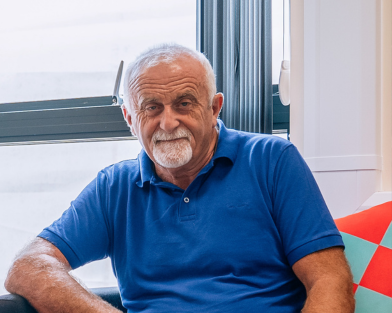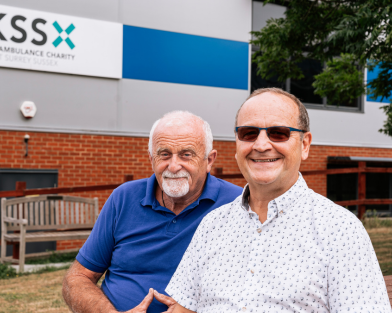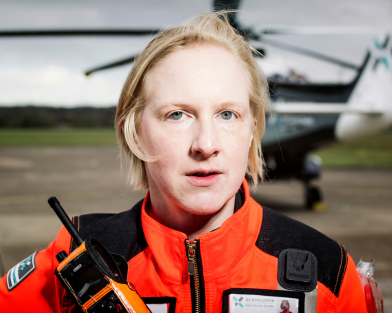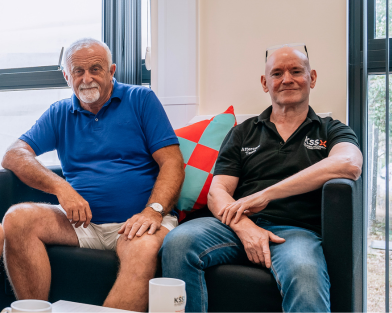“I was taking part in a Parkrun on 4 March 2023 when I collapsed within 50 metres of the finish. For a moment, people thought I had just fallen over, but I‘d suffered a cardiac arrest.
I’ve been told my eyes were rolling and I was gasping like a fish and it was clear that something was badly wrong. A lady who was running just behind me knew CPR. She came over and started giving me compressions immediately. I think six or seven other people also acted quickly to help with the CPR and the Parkrun organiser went and got a defibrillator from her car. Thankfully the second shock from the defibrillator got my heart beating again.
Then the emergency services arrived, including an ambulance and KSS.
Alongside the ambulance crew, the team from KSS treated me before loading me on the helicopter and taking me to the William Harvey Hospital in Ashford, where they specialise in cardiac care. I later learned that, by coincidence, Jon Honeyman, who has become a good friend, was four minutes behind in the other KSS helicopter. Jon, a similar age to me, had also suffered a cardiac arrest just a few miles away at the same time as me. Our paths crossed in the cardiac ward.
Dr Kat Hunter, part of the KSS team that cared for Martyn recalls arriving at the scene:
“As we circled the scene overhead so that the pilots could check for somewhere to land safely, I saw Martyn on the ground and saw lots of people around him. I could also see that CPR wasn’t ongoing. That immediately had me thinking `good, ok, they’ve got him back’. We needed to land and carry on this chain of survival.
Martyn had everything going right for him. He’d had bystander CPR, and early defibrillation. Everything was running in the right direction for him to be someone who was going to wake up and be talking to his loved ones. The focus for us was to provide the critical care that Martyn still needed, fast.
We quickly formulated a plan with everybody on scene. The first thing was to give him an anaesthetic, which we call a rapid sequence induction or RSI, so we could do all the things necessary to optimise his breathing and his circulation to give his brain the best chance.
We needed to get Martyn to hospital quickly for ongoing specialist cardiac care. Although there were some really positive signs, he was very agitated. If he needed a procedure performing on his heart, the quicker we got him in there, the better it would be for his heart and his brain. The better the chances would be of him waking up and talking to his loved ones.
One of the things we did was put an arterial line into his wrist to monitor his blood pressure, which is an advanced intervention that KSS can bring.
Throughout the flight we were monitoring Martyn to make sure his oxygen and carbon dioxide levels were good. We were maintaining his blood pressure and keeping him sedated.
All the time we were in communication with Carol, our Helicopter Emergency Medical Service dispatcher, who is based at the South East Coast Ambulance 999 Emergency Operations Centre, to let her know our expected arrival time at the William Harvey Hospital. Then we became aware that, by coincidence, the other crew on duty from KSS had been to another patient in cardiac arrest not far away and were heading to the same hospital.
It’s lovely to hear that Martyn and Jon have made a good recovery and become friends. We don’t always know what happens to patients, so it is wonderful to feel that we played a vital part in his survival. Martyn received incredible initial bystander care at the scene in those first crucial minutes between the 999 call and the emergency services, including KSS arriving, so we were then able to continue his critical care and give him the best chance of a positive outcome.
If the people around Martyn hadn’t stepped in to do CPR and get a defibrillator, he wouldn’t have survived because his heart wouldn’t have been given a chance to restart. We’re very mindful when we arrive to treat patients like Martyn that some brilliant work has been done before we get there.”
Several people stepped forward to help Martyn:
“Quite a few people gave me CPR, and I think it has given them such a great feeling to know that they helped save somebody’s life. I want to hug them all!
That’s why KSS training so many people in how to give CPR and use a defibrillator for Restart a Heart is amazing. Imagine it was one of your family and you were standing there helpless because you didn’t know what to do. We were both so lucky to have people around us that knew how to do CPR.
When I was ready to go to the cardiac ward my family explained that I was going to meet a chap called Jon Honeyman and that we were going to be great friends. That’s exactly what’s happened, we just hit it off. We have a similar sense of humour, and we just naturally get on. Our wives also get on very well, and I think we will always be great friends because of what we have been through.
We are both living proof that knowing how to do CPR can save a life. I learned it while I was working at Gatwick. We did it to the tune of ‘Nelly the Elephant’ but you can also do it to ‘Staying Alive’.”
Martyn is keen to encourage everyone to support KSS:
“Neither Jon nor I knew what was going to happen that day. You know the air ambulance is around, but you just don’t think about it until it’s you or a loved one that needs it. Supporting the air ambulance is so important because it’s a charity and can have a big impact on people’s lives straight away.
We’re back to leading normal lives. And the only reason we’re doing that is, in my case, half a dozen people, the South East Coast Ambulance Service, KSS and the people at the William Harvey Hospital who helped us. But we would never have made it without the air ambulance. It’s as simple as that.”





